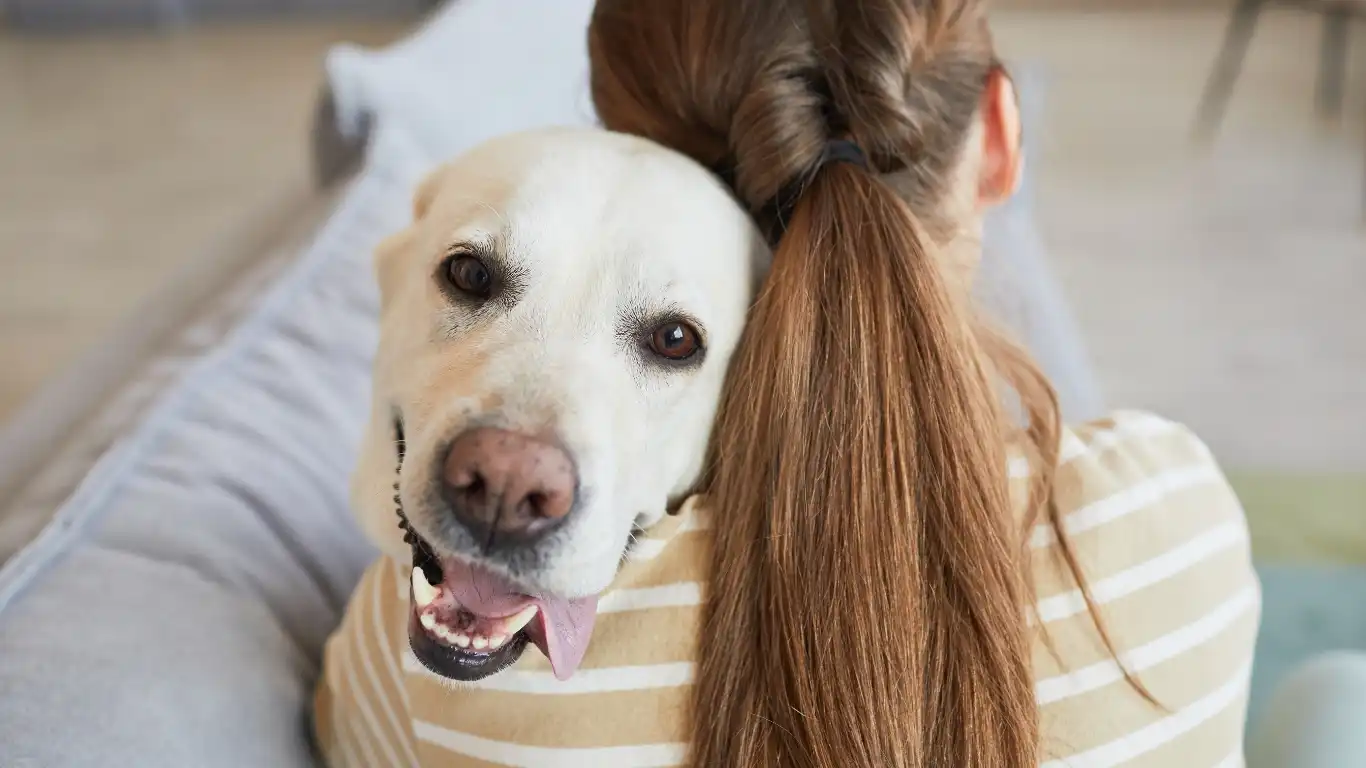How to Train a Dog to Not Bark at the Doorbell Calmly and Effectively
Ever had your dog turn into a full-blown security alarm every time the doorbell rings? I’ve been there too—trust me, it’s not fun when you’re expecting a guest and your pup’s barking frenzy makes it feel like the apocalypse is near. As a Veterinary Technician specializing in nutrition, you’d think most of my work is centered around food (and hey, it is), but I can’t count how many times pet parents have asked me how to train a dog to not bark at the doorbell calmly and effectively. It’s a super common issue, and the good news is—it’s totally fixable with the right approach and a bit of patience.
Understanding Why Dogs Bark at the Doorbell

First things first—before we even *think* about correcting the behavior, we’ve got to understand why it’s happening. Dogs aren’t trying to annoy us. Barking at the doorbell is their version of yelling “SOMEONE’S HERE!” It’s instinctual. And honestly? It’s kind of sweet. They’re just doing their job as protectors of the house.
Most of the time, it’s a mix of excitement, territorial behavior, and sometimes even anxiety. When the doorbell rings, it’s a sudden, loud sound that triggers a reaction. For some pups, it’s a rush of adrenaline; for others, it’s an alert that their space might be invaded. Recognizing this helps us reframe the barking not as “bad behavior” but as a communication problem we can gently rewire.
The Key to Calm Training? Routine and Reinforcement
I’ve seen way too many owners try to “shush” or yell over their barking dogs. Spoiler alert: that usually backfires. Instead, what I’ve found works best (especially with easily excitable dogs) is a calm, consistent training routine that involves desensitization and positive reinforcement.
- Desensitization: Gradually exposing your dog to the sound of the doorbell in a controlled way.
- Counter-conditioning: Teaching your dog a new behavior to perform instead of barking, like going to a mat or sitting quietly.
- Reward-based reinforcement: Using treats or praise to reward calm behavior when the bell rings.
Here’s a fun story—my own dog, Charlie, used to completely lose his mind at the sound of our vintage doorbell. We worked on this over a few weeks with the classic “bell = treat” method. Now, instead of barking, he trots over to his bed like a total gentleman. It’s doable. You just need a plan.
Start with Bell Desensitization Training

Let’s walk through it step-by-step, because I know it can feel a bit overwhelming at first. Training your dog to not bark at the doorbell calmly and effectively isn’t about silencing them—it’s about replacing the barking with a different reaction.
- Record the doorbell sound: Use your phone or a speaker to play it back at a low volume.
- Play the sound randomly: A few times a day, play the bell and immediately toss your dog a treat.
- Gradually increase the volume: Over several days, slowly raise the volume as your dog gets used to it without reacting.
- Add a cue: Teach a cue like “Place” or “Mat” so your dog has a job to do instead of barking.
It’s super important that you don’t rush this process. Some dogs pick it up fast, and others need a few weeks. That’s totally normal. If your pup reacts to the sound—even just a little—go back a step. We’re building confidence here, not stress.
Pro Tip: Timing is Everything
Seriously, if you reward your dog even a second too late, they might associate the treat with barking instead of being quiet. I recommend having treats in your pocket or a treat pouch during this phase so you can respond quickly and clearly. I love using freeze-dried liver treats—they’re stinky (in the best way) and high-value for most dogs.
Teach an Alternative Behavior for a Calm Reaction

Alright, so now that your dog isn’t reacting like a total tornado to the doorbell *sound* anymore, it’s time to teach them what to do *instead*. I always tell clients—and I say this from personal experience too—you can’t just tell a dog what not to do. You’ve gotta give them something better to do. Dogs love a job, especially if it comes with a paycheck (aka a tasty treat or a scratch in the right spot).
My go-to method? Teaching a reliable “go to your spot” cue. You can call it “Place,” “Mat,” “Couch,” whatever works for you. The goal is for your pup to hear the doorbell and automatically head to their designated calm zone.
- Start by picking a comfy mat or bed near—but not too close to—the door.
- With treats in hand, lure your dog to the spot and reward them for staying there, even for just a second at first.
- Add a cue word like “Place” as they go to the mat, then slowly build up the time they stay there.
- Now, pair this with the doorbell training. Doorbell rings? Cue them to go to their place, then reward the heck out of them for staying chill.
Charlie, my pup, absolutely loves his place cue now. He’ll run to his bed and do this overly dramatic “I’m so calm, look at me” pose because he knows there’s a liver treat coming. Dogs are funny like that—they catch on when there’s something in it for them.
Stay Consistent with Real-Life Practice

So, once you’ve built the behavior inside your controlled bubble, it’s time to take it live. I call this the “real-world rehearsal.” You’ll want to set up mock doorbell situations with friends or family—people your dog doesn’t live with. This helps your dog generalize the behavior and not just think, “Oh, it’s that fake bell again with Mom and her treat pouch.”
Here’s how I usually guide clients through this step:
- Ask a friend to ring the doorbell from outside, just like a normal visitor would.
- Keep your energy low. If you get excited or stressed, your dog will mirror that.
- Cue your dog to go to their mat or sit calmly, and only open the door once they’re settled.
- Reward after the door opens, not just when they hear the bell. This builds the idea that staying calm = good things.
I once had a Golden Retriever client who completely nailed this after just a few days of consistent practice. His owner was floored. She thought it would take months, but turns out, with the right timing and tone, some dogs are quick studies. That’s why I always tell folks—not all dogs learn at the same pace, and that’s okay.
Use Management Tools If Needed

Look, I’m not going to pretend this process works overnight or that every dog responds like a dream. Some dogs get so worked up over the doorbell that even treats or cues don’t register at first. And that’s where management comes in. It’s not a cop-out—it’s a smart way to keep the peace while you train.
Here are a few management tools I’ve recommended over the years:
- Baby gates or exercise pens: Create a physical barrier between your dog and the door to give them space.
- White noise machines: Mask the sound of the doorbell if you live in a busy neighborhood.
- Visual barriers: Block windows near the door if your dog is triggered by movement or shadows outside.
There’s absolutely no shame in using tools like these. In fact, when I was working with a hyper-reactive Border Collie (sweetest girl but soooo intense), we had to use a combo of white noise and baby gates for two whole weeks before she could focus during training sessions. Sometimes you just need to hit the “pause” button on their environment before they’re ready to learn.
What If My Dog Just Won’t Stop Barking?
Okay, real talk. If your dog is still barking after you’ve done all the right things, don’t get discouraged. Some dogs bark out of habit, some out of fear, and others because it’s just part of their personality. If you’re stuck, reaching out to a positive-reinforcement trainer or even a behaviorist can make a world of difference.
And don’t forget—sometimes barking is a sign of boredom or pent-up energy. If your dog’s not getting enough physical or mental exercise, they’re gonna find an outlet. I’ve seen a LOT of cases turn around once we added an extra walk, puzzle toys, or even some basic scent games into the daily routine.
Celebrate Small Wins and Track Progress

If you’ve made it this far, first off—go you! Training a dog to not bark at the doorbell calmly and effectively isn’t a one-size-fits-all journey. I’ve worked with plenty of pups, and every single one had their own “aha” moment at different times. And trust me, celebrating those tiny wins is so important—for you and your dog.
For example, if your dog barks 10 times when the doorbell rings, and now they’re only barking 3 times before settling, that’s huge. It means your training is working. And your dog’s brain is slowly rewiring how it responds to that doorbell chime. It may not feel like a complete win yet, but you’re getting there.
I recommend jotting down short notes each week. Doesn’t need to be anything fancy—just simple stuff like:
- “Monday: Barked 6x, went to mat after 2 cues”
- “Wednesday: One bark, then calm without cue ”
- “Saturday: Guest came over, she stayed in her bed the whole time!”
Tracking things like this helped me tremendously with a foster dog named Molly. She was a total doorbell screamer at first, but within a couple of weeks, those notes became my lifeline of hope. Seeing the steady progress written out gave me confidence to keep going. Sometimes you don’t realize how far you’ve come until you see it in writing.
When to Get Extra Help

Even though I’ve got a solid background as a vet tech specializing in nutrition, I’m the first to admit that some behavior cases need more than DIY fixes. So if your dog’s barking is rooted in anxiety, fear, or aggression, don’t wait too long to call in a professional.
Look for certified trainers who use positive reinforcement methods—no shock collars or harsh punishments. You want someone who understands canine behavior science and won’t make things worse with outdated “dominance” methods. A few trustworthy directories include:
Getting support doesn’t mean you’ve failed—it means you’re committed to your dog’s well-being. And honestly, it can save you a lot of time and frustration in the long run.
Tips for Long-Term Success and Maintenance
Once your dog has made progress, the work isn’t over. You’ll still need to reinforce those good behaviors and prevent backsliding. Dogs thrive on routine and consistency, so don’t let those good habits fade just because the barking has stopped.
Here are a few long-term tips I always pass along:
- Keep practicing with the doorbell a few times a week—even when you’re not expecting anyone.
- Keep rewarding calm behavior, even if it feels like your dog has “got it.”
- Let house guests know what your dog is working on and how they can help (like ignoring the dog until they’re calm).
- Stay patient. Some regressions are totally normal, especially after big life changes like moving, new pets, or visitors staying over.
Remember, this isn’t just about training—it’s about building trust between you and your dog. When your pup knows what to expect and feels safe, they’re much more likely to respond calmly and confidently.
Final Thoughts on Training Your Dog to Not Bark at the Doorbell
At the end of the day, training your dog to not bark at the doorbell calmly and effectively is all about understanding your dog’s emotions, setting realistic expectations, and creating a routine that supports their success. You’ve got this. Your dog wants to do well—they just need you to show them how.
And hey, if you ever feel stuck, overwhelmed, or just need a second opinion, don’t hesitate to reach out to a professional. You’re doing an amazing job, and your dog is lucky to have someone like you in their corner.
References
- Victoria Stilwell Positively
- Certification Council for Professional Dog Trainers (CCPDT)
- Karen Pryor Academy
Disclaimer
This article is based on my professional experience as a Veterinary Technician/Nurse with a specialization in nutrition and behavior support. It is intended for informational purposes only and does not replace personalized advice from a certified dog trainer or veterinarian. Always consult with a qualified professional for any behavior concerns or medical conditions related to your pet.






